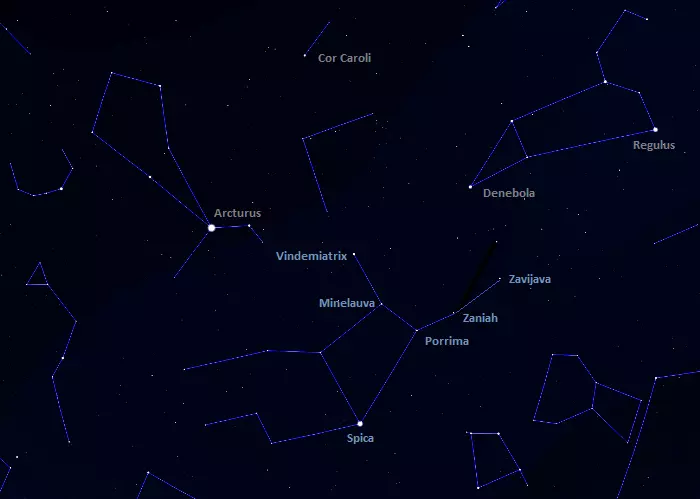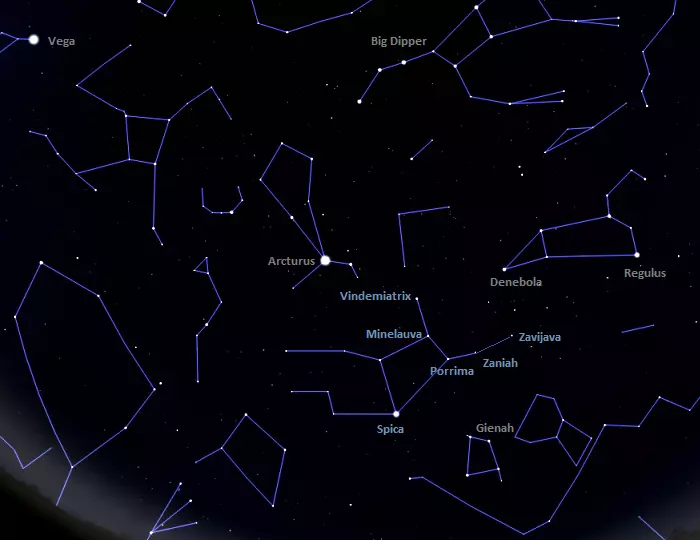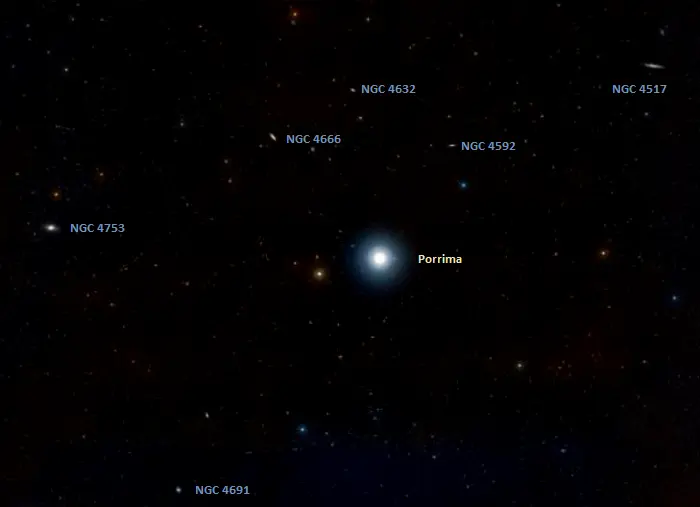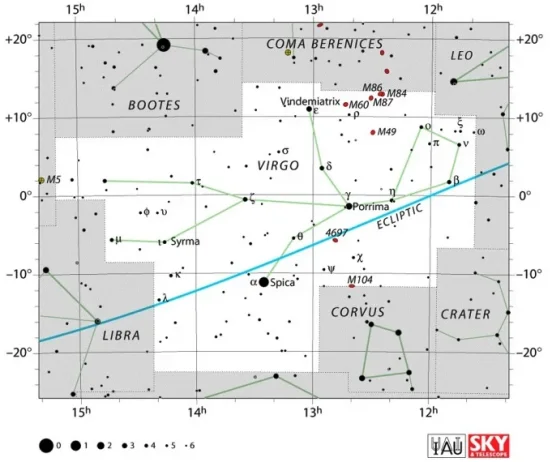Porrima, Gamma Virginis (γ Vir) is the primary component in a binary system located 38.1 light-years away in the constellation Virgo. With a combined apparent magnitude of 2.74, it is the second brightest star in Virgo, after Spica. It is one of the six bright stars that form the Y of Virgo, an asterism that dominates the western part of the constellation.
Star system
The Gamma Virginis system consists of two nearly identical dwarfs with an orbital period of 168.93 years and similar properties. Both stars have the stellar classification F0 V. The primary component, Gamma Virginis A, has a mass of 1.56 solar masses and a surface temperature of 6,757 K. The estimated age of the system is 1.14 billion years.
Gamma Virginis A shines a magnitude 3.65, while Gamma Virginis B is slightly brighter with an apparent magnitude of 3.56.
The two stars could be easily resolved until the 1990s, when the separation between became smaller. As of 2020, they can be resolved in a small telescope again.

Porrima (Gamma Virginis), image: Wikisky
Facts
Porrima is one of the six bright stars that form the Y of Virgo. The asterism is also formed by Spica (Alpha Virginis), Minelauva (Delta Virginis), Vindemiatrix (Epsilon Virginis), Zaniah (Eta Virginis), and Zavijava (Beta Virginis). It can be used to find the Virgo Cluster of galaxies. Spica, the brightest star in Virgo, appears at the base of the Y and Porrima is the middle star of the bowl. Minelauva and Vindemiatrix appear to the left of Porrima, and Zaniah and Zavijava to the right. The Virgo Cluster appears within the bowl of the Y. Its centre lies roughly halfway between Vindemiatrix and Denebola at the Lion’s tail.

The Y of Virgo, image: Stellarium
Porrima lies only 2.8 degrees north of the ecliptic (the Sun’s apparent path across the sky). It can be occulted by the Moon and, less often, by planets. Saturn passed a quarter of a degree south of the star in June 2011.
Name
The name Porrima (pronunciation: /ˈpɒrɪmə/) comes from Ancient Rome. In Roman religion, Porrima was a goddess of the future and prophecy. She was also known as Antevorta or Prorsa (a contraction of Proversa). These names were also used for Gamma Virginis.
The name Porrima was approved by the International Astronomical Union’s (IAU) Working Group on Star Names (WGSN) on July 20, 2016. It formally applies only to the component Gamma Virginis A but was traditionally used for the entire star system.
The 17th century Egyptian astronomer Al Achsasi al Mouakket called Gamma Virginis Laouiyet al Aoua, meaning “the angle of the barker,” in his Calendarium. In Arabic astronomy, Porrima formed an asterism called Al ʽAwwāʼ (the Barker) with Zavijava (Beta Virginis), Minelauva (Delta Virginis), Zaniah (Eta Virginis), and Vindemiatrix (Epsilon Virginis). The name Laouiyet al Aoua was translated into Latin as Angulus Latratoris.
In Chinese astronomy, Porrima was known as 太微左垣二 (Tài Wēi Zuǒ Yuán èr), the Second Star of Left Wall of Supreme Palace Enclosure. The Left Wall of Supreme Palace Enclosure was an asterism formed by Porrima with Minelauva (Delta Virginis), Zaniah (Eta Virginis), Vindemiatrix (Epsilon Virginis), and Diadem (Alpha Comae Berenices). The Supreme Palace Enclosure represented the imperial court. Porrima represented 東上相 (Dōngshǎngxiāng), the First Eastern Minister.
Location
Porrima is easy to find because it is part of the Y of Virgo. The asterism can be found using the stars of the brighter Big Dipper. The arc of the Dipper’s handle, formed by Alioth, Mizar, and Alkaid, first leads to Arcturus, the brightest northern star, and then to Spica. Spica sits at the base of the crooked Y and Porrima is the middle star forming the bowl of the Y.

The location of Porrima in Virgo, image: Stellarium
Several galaxies appear in the same line of sight as the star: the lenticular galaxy NGC 4753, the barred spiral galaxy NGC 4691, the spiral galaxies NGC 4666 and NGC 4632, the dwarf spiral galaxy NGC 4592, and the spiral NGC 4517.

The galaxies near Porrima, image: Wikisky
Constellation
Porrima is located in the constellation Virgo. Virgo is the second-largest constellation in the sky, after Hydra. It stretches across 1,294 square degrees of the sky around the celestial equator.
Like other zodiac constellations, Virgo was among the ancient constellations catalogued by Claudius Ptolemy in his Almagest in the 2nd century CE. In Greek mythology, it is associated with Demeter and Dike. In Roman times, it was linked with Ceres.
Virgo hosts Spica, the 16th brightest star in the sky. The hot blue main sequence star shines at magnitude 0.97 from a distance of 250 light-years. Other notable stars in Virgo include the yellow giant Vindemiatrix (Epsilon Virginis), the yellow-white giant Syrma (Iota Virginis), the orange giant Kang (Kappa Virginis), the nearby red dwarf Ross 128, and the yellow main sequence star 61 Virginis, which hosts three known extrasolar planets.

Virgo constellation map by IAU and Sky&Telescope magazine
Virgo is home to the Virgo Cluster of galaxies. The cluster contains up to 2,000 member galaxies, the brightest of which include the elliptical galaxies Messier 49, Messier 60, Messier 87, and Messier 89, the spiral galaxies Messier 58, Messier 61, and Messier 90, and the lenticular or elliptical Messier 84 and Messier 86. The famous Sombrero Galaxy (Messier 104) is not a member of the cluster, but it lies in Virgo and is one of the most recognizable galaxies in the night sky.
The best time of the year to observe the stars and deep sky objects in Virgo is during the month of May, when the constellation appears higher above the horizon in the evening. The entire constellation is visible from locations between the latitudes 80° N and 80° S.
The 10 brightest stars in Virgo are Spica (Alpha Vir, mag. 0.97), Porrima (Gamma Vir, mag. 2.74), Vindemiatrix (Epsilon Vir, mag. 2.826), Heze (Zeta Vir, mag. 3.376), Minelauva (Delta Vir, mag. 3.39), Zavijava (Beta Vir, mag. 3.604), 109 Virginis (mag. 3.72), Mu Virginis (mag. 3.88), Zaniah (Eta Vir, mag. 3.89), and Nu Virginis (mag. 4.04).
Porrima – Gamma Virginis
| Spectral class | F0 V + F0 V |
| U-B colour index | -0.05 |
| B-V colour index | +0.36 |
| Apparent magnitude | 2.74 (3.650 + 3.560) |
| Absolute magnitude | 2.41 |
| Distance | 38.1 ± 0.3 light-years (11.68 ± 0.08 parsecs) |
| Parallax | 83.1935 ± 0.5074 mas |
| Radial velocity | -19.5 km/s |
| Proper motion | RA: -605.176 ± 0.788 mas/yr |
| Dec.: 85.701 ± 0.401 mas/yr | |
| Mass | 1.56 M☉ |
| Temperature | 6,757 K |
| Metallicity | -0.07 dex |
| Age | 1.14 billion years |
| Surface gravity | 4.26 cgs |
| Constellation | Virgo |
| Right ascension | 12h 41m 39.6282288151s |
| Declination | –01° 26′ 57.854228847″ |
| Names and designations | Gamma Virginis, γ Vir, Antevorta, Arich, 29 Virginis, HIP 61941, SAO 138917, BD-00°2601, AG-01 1685, Gl 482 AB, LHS 2604, GC 17270, GCRV 7623, GCTP 2924.00, JP11 2269, IRAS 12390-0110, 2MASS J12413962-0126580, WDS 12417-0127 |
| Gamma Virginis A | Porrima, Gamma Virginis A, γ Vir A, HD 110379, HR 4825, LFT 937, LTT 4843, NLTT 31564, PLX 2924, TYC 4949-1120-1, Gaia DR2 3683687763520080384, Gaia DR3 3683687763520080384 |
| Gamma Virginis B | Gamma Virginis B, γ Vir B, HD 110380, HR 4826, LFT 937, LTT 4844, NLTT 31565, TYC 4949-1120-2, Gaia DR2 3683687763520080256, Gaia DR3 3683687763520080256 |